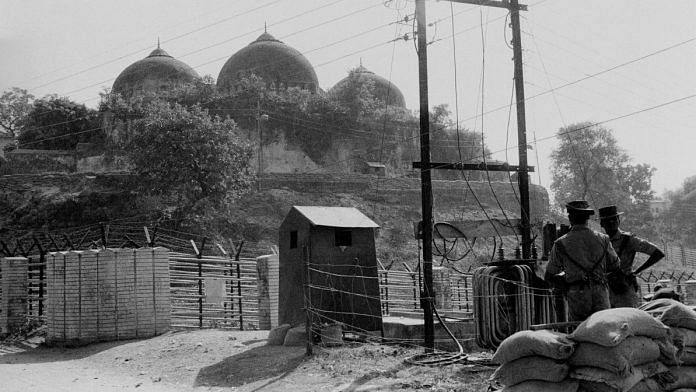New Delhi: In the Supreme Court’s Ayodhya verdict announced Saturday, an Archaeological Survey of India (ASI) report released in 2003 played a key role. The report had stated that remains of a “Hindu structure” were found at the disputed Babri Masjid-Ram Janmabhoomi site.
As it ordered the construction of Ram temple, the apex court ruling, based on the ASI report, drew the inference that the “foundation of the (16th century) mosque was based on the walls of a large pre-existing structure that dates back to the twelfth century”. It also said the “recoveries were suggestive of a structure of Hindu religion origin”.
The judgment also noted that the ASI report indicated “that pre-existing underlying structure has large dimensions, evident from the fact that there were 85 pillar bases comprised in 17 rows each of five pillar bases”.
These observations came over 16 years after the ASI excavated the disputed Ayodhya site, between May and June in 2003, on the directions of a Lucknow bench of the Allahabad High Court. The result was a 574-page report which was submitted to the court in August of that year.
The report has since served as crucial evidence in studying the ownership of the disputed site.
Also read: Muslims deprived of mosque by means not suited to secular nation, says SC
What ASI found during excavation
In the 2003 excavation, the Archaeological Survey of India made discoveries that were indicative of features associated with temples in north India, according to a PTI report from the time.
Among the excavation yields, the ASI reportedly found stone and decorated bricks, mutilated sculpture of divine couple, carved architectural members including foliage patterns, amalaka, kapotapali, doorjamb with semi-circular shrine pilaster, broken octagonal shaft of black schist pillar, lotus motif, circular shrine having pranjala (watershute) in the north and 50 pillar bases in association with a huge structure.
The ASI report said during the early medieval period (11-12th century AD) a huge structure of nearly 50 metres, with north-south orientation, was constructed. But it seemed to have been short-lived.
Towards east of the central point of the earlier structure, the report said in a significant observation, ASI found a circular depression with projection on the west, cut into the large-sized brick pavement, signifying that some important object was placed there.
The report also mentioned pillar bases that were used for construction of massive walls.
Later, referring to the construction of a mosque over the earlier structure, the report added that a massive structure with at least three structural phases and three successive floors were constructed on the remains.
To further this point, the ASI report said, “The architectural members of the earlier short-lived massive structure with stencil-cut foliage pattern and other decorative motifs were reused in the construction of the monumental structure.”
The ASI survey of 2003 was the fifth such historical topography of Ayodhya, said a report in The Hindu.
“A.E. Cunningham conducted the first survey in Ayodhya in 1862-63 followed by another in 1889-91 by A. Fuhrer. Professor A.K. Narain conducted the third excavation in Ayodhya in 1969-70, and finally, Professor B.B. Lal conducted a more intensive and revealing study of the area in 1975-76,” it said.
The intention of Cunningham’s survey was to relocate Buddhist sites and establish the Buddhist antecedents of Ayodhya. In his report, he asserted that the present-day Ayodhya was the Ayodhya of Ramayana years.
Also read: SC invoked Article 142 to order formation of trust for Ram Mandir. Here’s what it means
‘No answer for reason of destruction’
The ASI report has been discussed in detail in the Supreme Court judgment Saturday. While referring it to make the points mentioned above, the court also noted that the report leaves some questions unanswered.
“It does not answer the reason for the destruction of the pre-existing structure and whether the earlier structure was demolished for the purpose of construction of the mosque,” the court said in its 1,045-page judgment.
“It also adds that since the ASI report dates the underlying structure to the twelfth century, there is a time gap of about four centuries between the date of the underlying structure and the construction of the mosque,” said the order. “No evidence is available to explain what transpired in the course of the intervening period of nearly four centuries.”
The Supreme Court said “a finding of title cannot be based in law on the archaeological findings which have been arrived at by ASI”.
“Title to the land must be decided on settled legal principles and applying evidentiary standards which govern a civil trial,” it added.
Also read: RSS won’t push Varanasi, Mathura mosque issues after Ayodhya verdict, says Mohan Bhagwat



